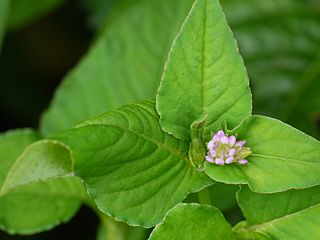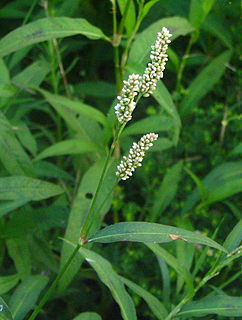
The Polygonaceae are a family of flowering plants known informally as the knotweed family or smartweed—buckwheat family in the United States. The name is based on the genus Polygonum, and was first used by Antoine Laurent de Jussieu in 1789 in his book, Genera Plantarum. The name may refer to the many swollen nodes the stems of some species have, being derived from Greek, poly meaning 'many' and gony meaning 'knee' or 'joint'. Alternatively, it may have a different derivation, meaning 'many seeds'.
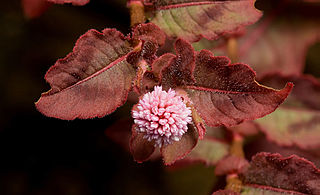
Persicaria is a genus of herbaceous flowering plants in the knotweed family, Polygonaceae. Plants of the genus are known commonly as knotweeds or smartweeds. It has a cosmopolitan distribution, with species occurring nearly worldwide. The genus was segregated from Polygonum.

Persicaria perfoliata is a species of flowering plant in the buckwheat family. Common names include mile-a-minute, devil's tail, giant climbing tearthumb, and Asiatic tearthumb. It is a trailing herbaceous annual vine with barbed stems and triangular leaves. It is native to most of temperate and tropical eastern Asia, occurring from eastern Russia and Japan in the north, and the range extending to the Philippines and India in the south. P. perfoliata is an aggressive, highly invasive weed.

The docks and sorrels, genus Rumex, are a genus of about 200 species of annual, biennial, and perennial herbs in the buckwheat family, Polygonaceae. Members of this genus are very common perennial herbs with a native almost worldwide distribution, and introduced species growing in the few places where the genus is not native.

The genus Fagopyrum is in the flowering plant family Polygonaceae. It includes some important food plants, such as F. esculentum (buckwheat) and F. tataricum. The genus is native to the Indian subcontinent, much of Indochina, and central and southeastern China. Species have been widely introduced elsewhere, throughout the Holarctic and parts of Africa and South America.

Polygonum is a genus of about 130 species of flowering plant in the buckwheat and knotweed family Polygonaceae. Common names include knotweed and knotgrass. In the Middle English glossary of herbs Alphita, it was known as ars-smerte. There have been various opinions about how broadly the genus should be defined. For example, buckwheat has sometimes been included in the genus as Polygonum fagopyrum. Former genera such as Polygonella have been subsumed into Polygonum; other genera have been split off.

Persicaria maculosa is an annual plant in the buckwheat family, Polygonaceae. Common names include lady's thumb, spotted lady's thumb, Jesusplant, and redshank. It is widespread across Eurasia from Iceland south to Portugal and east to Japan. It is also present as an introduced and invasive species in North America, where it was first noted in the Great Lakes region in 1843 and has now spread through most of the continent.

Persicaria pensylvanica is a species of flowering plant in the buckwheat family, Polygonaceae. It is native to parts of North America, where it is widespread in Canada and the United States. It has also been noted as an introduced species in parts of Europe and South America. Common names include Pennsylvania smartweed and pinkweed.
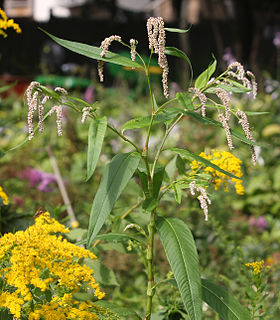
Persicaria lapathifolia, known as pale persicaria, is a plant of the family Polygonaceae. It is closely related to Persicaria maculosa and as such is considered a weed in Britain and Europe. Other common names for the plant include pale smartweed, curlytop knotweed, and willow weed. It is a species complex made up of a great many varying forms, sometimes considered varieties. The environment also has a strong influence on the morphology of an individual plant.

Muehlenbeckia or maidenhair is a genus of flowering plants in the family Polygonaceae. It is native to the borders of the Pacific, including South and North America, Papua New Guinea and Australasia. It has been introduced elsewhere, including Europe. Species vary in their growth habits, many being vines or shrubs. In some environments, rampant species can become weedy and difficult to eradicate.

Persicaria filiformis is a species of flowering plant in the family Polygonaceae, native to the Kuril Islands, Japan, Korea, Myanmar, the Philippines and Vietnam. It was first described as Polygonum filiforme in 1784 by Carl Thunberg and transferred to the genus Persicaria in 1819 by Takenoshin Nakai. The species has been treated as the variety filiformis of Persicaria virginiana, a North American species.

Persicaria capitata, the pink-headed persicaria, pinkhead smartweed, pink knotweed, Japanese knotweed, or pink bubble persicaria, is an Asian species of plants in the genus Persicaria within the buckwheat family. It is native to Asia and grown as an ornamental in other countries. It has become naturalized in Australia, South Africa and a few scattered locations in the United States.
Persicaria cespitosa, known as tufted knotweed, is a summer annual weedy plant of the family Polygonaceae, native to eastern Asia, from China to Japan and Southeast Asia, and introduced into North America. The plant grows to 3.5 feet (105 cm) in height with elliptic to lanceolate leaves, usually 20–75 mm long. It has small pink or red flowers arranged in tight terminal spikes.

Bistorta is a genus of flowering plants in the family Polygonaceae. As of February 2019 about 40 species are accepted. It has been supported as a separate clade by molecular phylogenetic analysis. Bistorta species are native throughout much of the Northern Hemisphere, as far south as Mexico in North America and Thailand in Asia.

Duma florulenta, commonly known as tangled lignum or often simply lignum, is a plant native to inland Australia. It is associated with wetland habitats, especially those in arid and semiarid regions subject to cycles of intermittent flooding and drying out. The Wiradjuri name for the plant is gweeargal.

Muehlenbeckia australis, the large-leaved muehlenbeckia or pohuehue, is a prostrate or climbing plant native to New Zealand.
Persicaria posumbu is a species of flowering plant in the family Polygonaceae. It was first described as Polygonum posumbu in 1825 and transferred to the genus Persicaria in 1919. Plants of the World Online records it as having a discontinuous native distribution: the Assam region, Bangladesh and the eastern Himalayas to the west, and Japan, Korea, the Kuril Islands and Primorye to the east.

Koenigia polystachya is a species of flowering plant in the knotweed family, known by the common names Himalayan knotweed and cultivated knotweed. It has several regularly used synonyms, including Polygonum polystachyum, Aconogonon polystachyum and Persicaria wallichii.
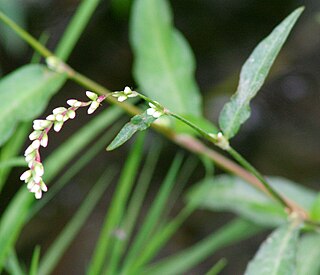
Persicaria mitis(Schrank) Assenov is a species of flowering plant in the family Polygonaceae, native to Europe.

Persicaria orientalis is a species of flowering plant in the family Polygonaceae, known as kiss-me-over-the-garden-gate and princess-feather. It was first described, as Polygonum orientale, by Carl Linnaeus in 1753. It was transferred to the genus Persicaria by Édouard Spach in 1841. Its native distribution is unclear. As of May 2019, Plants of the World Online lists only Uzbekistan, whereas other sources give a much wider distribution in temperate and tropical Asia and Australia. It is widely cultivated and naturalized.


